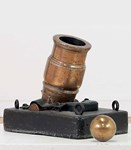As dealers involved in import and export will know, the process can be a difficult and time-consuming business, especially where antique ivory is involved.
Sometimes things go very wrong. But take heart, there is always hope and the problem is usually retrievable.
An issue dumped on my desk went as follows.
The work was an import from the Far East. It contained ivory. Impressively, the clients had already managed to obtain exemption under the Ivory Act and presented a bona fide certificate from DEFRA stating at the top: ‘Ivory Act 2018: a certificate for a pre-1918 item of outstandingly high artistic, cultural or historical value’.
So far, so good.
The client was well experienced and had her own longstanding shipping and legal advisers in the Far East.
This important piece was being exported, and imported into the UK, for one of the high-end fairs.
As those who deal in ivory will know, apart from the usual import/export paperwork, the Convention on International Trade in Endangered Species of Wild Fauna and Flora (CITES) sets out the international legal position on the trade in ivory.
According to CITES, all commercial, international and domestic trading in the realm of African and Asian elephant products is prohibited, minus a very small number of exceptions. The clients had already done well in obtaining their Ivory Act exemption; not an easy task.
So the dealer needed to make an application for an import permit under the CITES guidelines.
The lawyers in the Far East duly began their communications with the English CITES authorities.
Try as they might, they had entered a Kafkaesque world of auto-replies, eg “the guidance states that we aim to process applications within 35 working days, this is in consideration of the Prescribed Institution’s capacity required for an exemption criteria assessment. In addition, some applications might take longer due to the complexity or expertise required to assess the item.”
The lawyers endeavoured to expedite the matter, stressing the urgency at every point.
They sought to ensure that all documentation was in good order. They modified documents where required. They were asked for more documentation and completed that promptly. Time travelled on, all to no avail.
The fair was coming up shortly.
Eventually the lawyers consulted the local Customs Service. The advice received from Customs was that, at least in the Far East country of origin, if the work was imported there without the necessary permit, it would merely be held, and placed into custody, until the relevant permit was obtained and then released thereafter.
Feeling there was no choice now, the work was imported into the UK in any event. With no CITES permit.
It was immediately impounded by Border Force.
The issue was then promptly sent my way for a solution. There exists the possibility of obtaining what is known as a ‘Retrospective CITES import permit’ but the official APHA advice is that these are very rarely granted.
So, we collectively provided to the authorities involved a very full narrative of the labyrinthine course of events so far.
Additionally I telephoned APHA and was lucky enough to speak to an extremely helpful Case Officer who listened carefully and was very practical. The retrospective permit arrived just three days before the fair. We were lucky - it is much better to get everything in order well beforehand.
Milton Silverman is senior commercial dispute resolution partner at Streathers Solicitors LLP, London.















